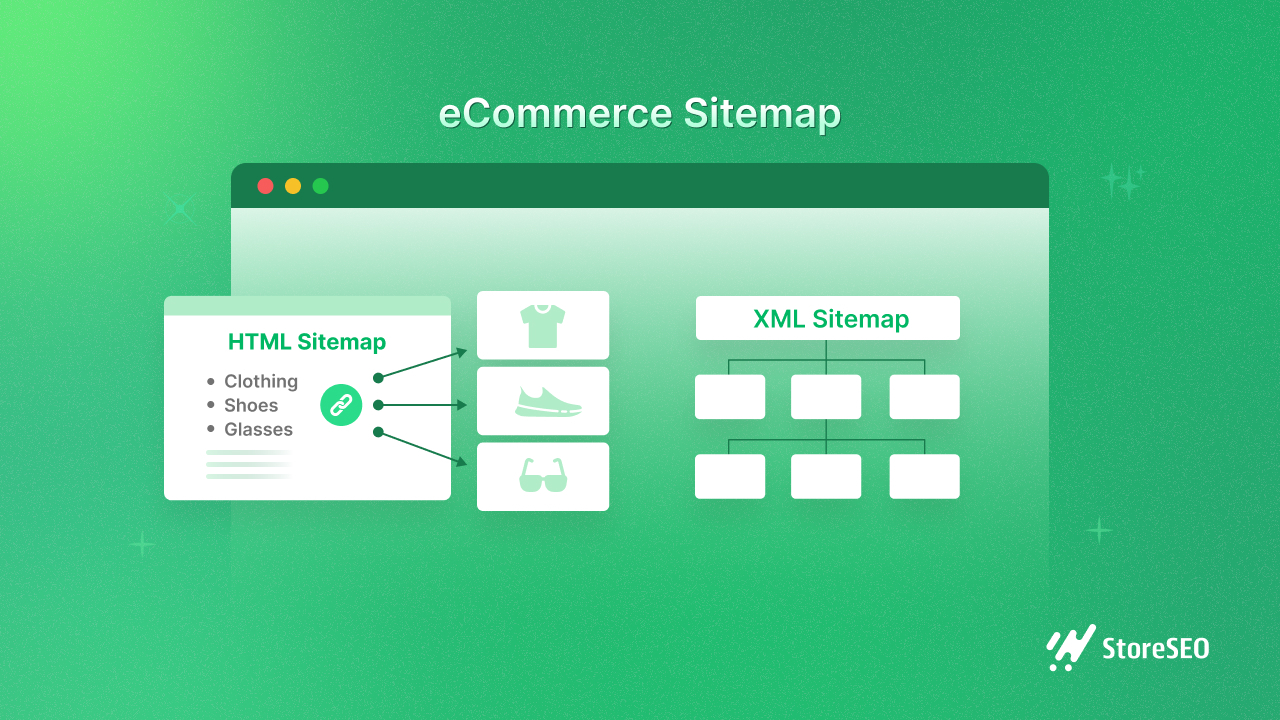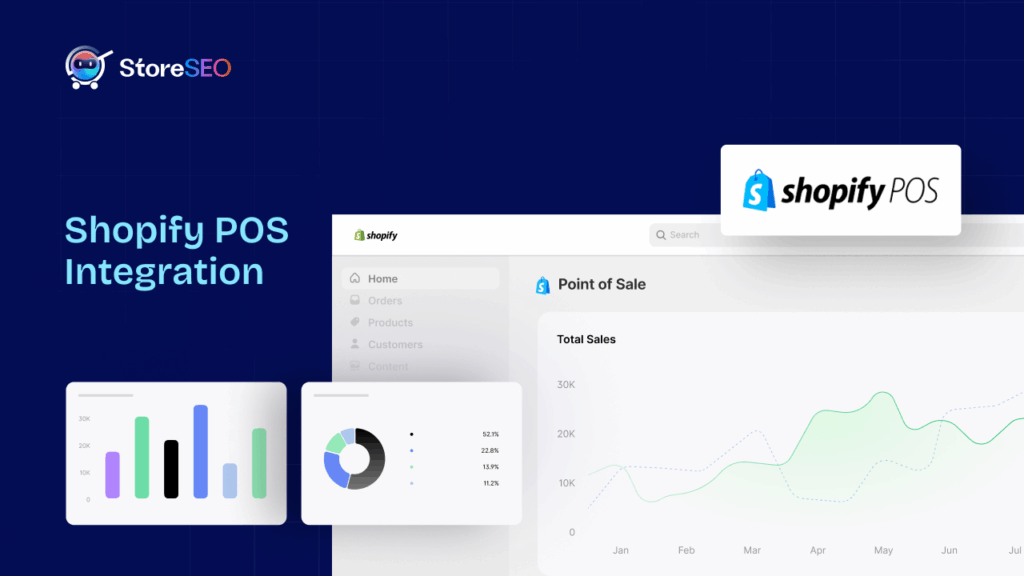De E-commerce sitemap helpt om de crawlability en indexering van uw winkel te verbeteren om organisch verkeer te genereren. Als u een grote e-commercewinkel hebt, kan een sitemap uw ultieme sleutel tot succes zijn in het SEO-spel. In deze blog bespreken we de ins en outs van e-commercesitemaps. Dus laten we zonder verder oponthoud beginnen.

Wat is een e-commerce sitemap?
Een eCommerce sitemap betekent dat het de kaart is van uw eCommerce winkel. Het helpt zoekmachine crawlers om uw webpagina's te vinden en te begrijpen. Het is in principe een structuur van de website die alle verschillende pagina's, categorieën en producten bevat die beschikbaar zijn in uw winkel. Dus, zoekmachine crawlers kunnen gemakkelijk alle pagina's ontdekken via deze kaart.
Soorten sitemaps voor e-commercewinkels
Sitemaps worden hoofdzakelijk ingedeeld in twee typen: XML-sitemap en HTML-sitemap. Hieronder vindt u meer details over deze sitemaps.
XML-sitemap
De XML-sitemap is een kaart voor zoekcrawlers om al uw webpagina's te vinden en te begrijpen. Het bevat een lijst met alle pagina-URL's van uw website op een gestructureerde manier.
HTML-sitemap
De HTML-sitemap is speciaal ontworpen voor websitebezoekers. Het helpt om alle pagina's van een website op één plek te vinden.
XML versus HTML e-commerce sitemap
| Vergelijkingspunt | XML e-commerce-sitemap | HTML e-commerce sitemap |
| Doel | Ontworpen voor zoekmachines | Ontworpen voor mensen |
| Inhoud | Metagegevens over de webpagina's, zoals hun belang, updatefrequentie en relatie tot andere URL's binnen de site. | Concentreer u op het bieden van een gebruikersvriendelijke navigatie-ervaring door links hiërarchisch en categorisch te organiseren |
| Gebruiksgeval | Helpt bij het indexeringsproces voor verschillende zoekmachines en verbetert de zichtbaarheid van de website in zoekresultaten. | Dient als een gebruiksvriendelijke kaart waarmee bezoekers snel specifieke pagina's of producten vanaf één pagina kunnen vinden |
Andere soorten sitemaps die in e-commercewinkels worden gebruikt
Eerder hebben we de twee belangrijkste typen sitemaps besproken. Naast deze zijn er echter nog drie andere typen die veel worden gebruikt in e-commercewinkels. Laten we hieronder dieper ingaan op deze sitemaps.
TXT(tekst) Sitemap
De TXT (tekst) Sitemap is een eenvoudig tekstbestand dat een lijst bevat van al uw pagina-URL's in platte tekst. In tegenstelling tot XML-sitemaps bieden TXT-sitemaps niet zoveel details voor crawlers van zoekmachines.
Afbeelding Sitemap
Een image sitemap is een ander soort XML sitemap die zoekmachines helpt bij het crawlen van afbeeldingen op uw website. Het bevat HTML tags om specifieke afbeeldingen te identificeren om crawlers te helpen uw website te begrijpen.
Videositemaps
De videositemap biedt aanvullende informatie over de video's die u op uw website host. Het helpt de crawlers van zoekmachines om de video-inhoud van uw website te begrijpen en te vinden door aanvullende informatie te bieden, zoals videotitel, beschrijving, duur en miniatuurafbeeldingen.
Wat is het beste sitemapformaat voor e-commerce?
Van de verschillende soorten sitemaps is XML sitemap de beste keuze voor e-commerce websites. Wanneer u een grote e-commerce website heeft, kan een XML sitemap de crawlers van zoekmachines helpen om al uw pagina's gemakkelijk te vinden.
Bovendien is een HTML-sitemap een geweldige toevoeging aan e-commercewinkels. Wanneer u veel categorieën en pagina's in uw winkel hebt, kan een HTML-sitemap u helpen om al die pagina's en categorieën op één plek te brengen. Op deze manier kunnen uw bezoekers elke specifieke pagina die ze zoeken gemakkelijk vinden.
Wat is inbegrepen in een e-commerce sitemap
eCommerce sitemap bevat informatie over uw website op een gestructureerde manier. Het bevat de URL's van uw website in de … tag. Dit is de bovenliggende tag voor de URL's van uw website waar u verdere informatie kunt toevoegen via onderliggende tags.
In de e-commerce sitemap staat de tag wordt gebruikt om de canonieke URL's te specificeren. Bovendien is de tag bevat de informatie over de paginawijziging. Op dezelfde manier kunt u tags gebruiken zoals En om de prioriteit en updatefrequentie van elke pagina te specificeren om de zoekmachines te helpen uw pagina's beter te begrijpen. Zie het volgende voorbeeld van een XML eCommerce-sitemap.

Hoe helpt sitemap bij SEO voor e-commercewinkels?
Sitemaps helpen bij SEO van e-commercewinkels door efficiënte crawlbaarheid en navigatie voor de zoekmachine en bezoekers te garanderen. Laten we hieronder dieper ingaan op de voordelen van sitemaps.
Verbeter de gebruikerservaring en navigatie
Een e-commercewebsite bevat heel veel links en verschillende pagina's. Bezoekers kunnen er gemakkelijk in verdwalen. Dus als het gaat om navigatie en gebruikerservaring, kan een e-commercesitemap handig voor u zijn. Bekijk de Crunchbase-website om te zien hoe ze alle links zo organiseren dat navigatie eenvoudig is.

Verbeter de crawlbaarheid en indexering
Een sitemap biedt crawlers van zoekmachines een routekaart van de structuur van uw website, waardoor ze alle pagina's efficiënter kunnen ontdekken en navigeren. Dit is vooral handig voor grote e-commerceplatforms met veel verschillende categorieën producten en pagina's. Wanneer u alle URL's van uw website toevoegt aan de sitemap, zoals productvermeldingen, categoriedirectory's en belangrijke landingspagina's, helpt dit de bots van zoekmachines om uw website eenvoudig te crawlen.
Houd interne en externe links op één plek
Wanneer u miljoenen interne en externe links op uw e-commercesite hebt, zullen zoekmachinecrawlers het moeilijk hebben om ze allemaal te volgen. Met een XML-sitemap kunt u al uw interne en externe links eenvoudig op één plek bewaren, zodat ze uw websitestructuur gemakkelijker kunnen begrijpen voor indexering.
Prioriteits- en frequentie-instellingen beheren
Met de XML-sitemap kunt u de prioriteit en updatefrequentie van elke pagina instellen. Dit helpt zoekmachines om het belang van verschillende pagina's te bepalen en hoe vaak ze moeten worden gecrawld voor updates. U kunt bijvoorbeeld productpagina's prioriteit geven boven andere, minder belangrijke pagina's.
Beste manier om een e-commerce sitemap voor Shopify te maken
In deze sectie gaan we je begeleiden bij het maken van e-commerce sitemaps voor je Shopify-winkel. Volg dus de onderstaande stappen om sitemaps voor je winkel te genereren.
Hoe maak je een XML-sitemap in Shopify
Shopify genereert automatisch een XML-sitemap voor uw winkel. U hoeft dus geen XML-sitemap voor uw winkel te maken. Om uw sitemap te vinden, moet u "/sitemap.xml" aan het einde van uw winkel-URL toevoegen en de link bezoeken. Omdat het een automatisch gegenereerde sitemap is, hebt u een Shopify-sitemapgenerator zoals StoreSEO nodig om uw sitemap bewerken of bijwerken.
Hoe maak je een HTML-sitemap in Shopify
HTML-sitemaps verbeteren de gebruikerservaring voor uw bezoekers. De StoreSEO-app kan u helpen gratis HTML-sitemaps te maken in Shopify. Volg de onderstaande stappen om een HTML-sitemap voor Shopify winkels.
Stap 1: Installeer StoreSEO in uw winkel
Allereerst zal je installeer StoreSEO in je Shopify-winkel. Zoek StoreSEO in de app store en installeer het in je winkel.

Stap 2: Genereer een sitemap voor Shopify
Nadat u StoreSEO hebt geïnstalleerd, gaat u naar de HTML-sitemap en klikt u op de 'Genereren' knop. Dat is het, dit is hoe je eenvoudig een sitemap kunt genereren in Shopify met StoreSEO. Nu kun je je HTML sitemap URL van daaruit kopiëren en deze link overal toevoegen waar je maar wilt. Als je stap voor stap wilt leren, kun je dit lezen documentatie.

Als u andere e-commerceplatforms gebruikt
Heb je een e-commercewebsite op andere platforms? In dat geval kun je de snelle tutorial hieronder lezen om je sitemap te maken.
Sitemap maken in WooCommerce (WordPress)
Voor WooCommerce kun je eenvoudig je sitemap maken met een SEO-plugin zoals Rank Math. Dit is hoe je een sitemap in WordPress kunt maken:
- Installeer en activeer Rank Math op uw website.
- Ga naar de instellingen van de plugin en schakel XML-sitemaps in.
- De plugin genereert automatisch een sitemap voor uw WooCommerce-winkel.
Sitemap maken in BigCommerce
BigCommerce genereert en updatet uw sitemap automatisch. Zodra ingeschakeld hoeft u zich geen zorgen meer te maken over de sitemap. Hier is een korte tutorial voor u:
- Meld u aan bij uw BigCommerce-dashboard.
- Ga naar Winkelinstellingen → 'Winkelpui'.
- Schakel in het gedeelte XML-sitemap de XML-sitemap in.
Sitemap maken in Wix
Het website-bouwplatform Wix genereert automatisch een sitemap voor uw website. Hier is een korte tutorial over hoe u uw sitemap indient:
- Meld u aan bij uw Wix-account.
- Ga naar het dashboard van uw site en klik op 'Zoekmachineoptimalisatie' (onder Marketing & SEO).
- Selecteer 'Sitemap' en klik vervolgens op 'Sitemap indienen.
Sitemap maken in Squarespace
In Squarespace kun je ook eenvoudig een sitemap maken. Zo maak je een sitemap in Squarespace:
- Meld u aan bij uw Squarespace-account.
- Ga naar 'Instellingen' → 'Geavanceerd'→'Zoekmachineoptimalisatie'.
- Scroll naar beneden naar het gedeelte Sitemap en klik op de 'Sitemap genereren' knop.
Hoe u een sitemap indient op Google Search Console
Zodra u een sitemap voor uw winkel hebt gemaakt, moet u deze indienen bij Google Search Console. Voor uw Shopify-winkel kunt u uw sitemap handmatig indienen bij Google of de StoreSEO-app gebruiken. Volg de onderstaande tutorial om uw sitemap in te dienen.
Hoe u handmatig een sitemap kunt indienen
Als u voldoende technische SEO-kennis hebt, kunt u uw sitemap handmatig indienen bij Google Search Console. Allereerst moet u verbind uw winkel met Google Search Console handmatig en ga vervolgens naar het tabblad Sitemap in Google Search Console.
Voer nu de URL van uw sitemap in en klik op 'Indienen' knop. Zodra u uw winkel hebt verbonden, typt u gewoon "/sitemap.xml” voordat u op de knop Verzenden klikt.

Hoe u een sitemap indient met StoreSEO
Als u niet veel technische expertise in SEO hebt, kunt u StoreSEO gebruiken om uw sitemap in te dienen. Het heeft integratie met Google Search Console, daarom kunt u uw sitemap indienen voor uw Shopify-dashboard.
Navigeer gewoon naar de 'Instellingen'→'Google-integratie tab en geef dan de benodigde toestemming door gewoon op de knoppen te klikken. Zo kunt u eenvoudig uw sitemap indienen bij StoreSEO. U kunt lezen deze documentatie voor stapsgewijze instructies.

Hoe u de sitemap-URL maakt: beste werkwijze
Zoals eerder vermeld, maakt Shopify sitemaps en URL's automatisch aan, u hoeft zich geen zorgen te maken over best practices voor sitemap-URL's. Hier zijn de richtlijnen die u moet volgen bij het genereren van een sitemap-URL:
Gebruik het rootdomein
Plaats de sitemap op het rootniveau van uw domein (bijv. https://www.example.com/sitemap.xml). Dit zorgt voor eenvoudige toegankelijkheid en standaardisatie in zoekmachines.
E-commerce sitemap best practices: om SEO-voordelen te maximaliseren
Sitemaps helpen uw SEO te verbeteren door verbeterde crawlability. Het werkt als een kaart voor uw website naar de zoekmachinebots. In deze sectie gaan we enkele van de beste werkwijzen delen die u moet volgen om uw SEO-voordelen te maximaliseren.
Sitemap regelmatig bijwerken
Wanneer u een sitemap regelmatig bijwerkt, helpt dit de crawler de wijzigingen te begrijpen die u op uw website aanbrengt. Hier zijn de do's en don'ts van het bijwerken van een sitemap.
| Doen | Wat je niet moet doen |
| ⭐ Voeg uw nieuwe pagina's toe ⭐ Verwijder de verwijderde pagina's ⭐ Zorg ervoor dat u de frequentie en prioriteit bijwerkt ⭐ Gebruik de laatste wijzigingsdata ⭐ Test uw sitemap om deze foutloos te houden | ⭐ Gebruik geen irrelevante URL's of links met dubbele of lage kwaliteit inhoud ⭐ Vergeet niet de wijzigingen door te geven ⭐ Misbruik de frequentie en prioriteit niet ⭐ Negeer de foutmelding niet |
Veelgestelde vragen
Voordat we dit artikel afsluiten, willen we nog enkele veelvoorkomende vragen beantwoorden die u in communities en forums tegenkomt.
Is een ontbrekende of onvolledige sitemap slecht voor e-commercewinkels?
U hebt misschien veel discussies gezien over ontbrekende of onvolledige sitemaps en bent waarschijnlijk op zoek naar het juiste antwoord. Nou, een eCommerce-sitemap helpt zoekmachines om uw pagina's te ontdekken. Wanneer u een grote winkel hebt, zorgen sitemaps voor een goede crawlbaarheid van uw winkel.
Als u echter een kleine winkel hebt, is het indienen van een sitemap geen must voor u. In plaats daarvan is het interlinken van uw pagina's belangrijker voor u om de crawlers van zoekmachines te begeleiden. In dat geval moet u uw interne paginanavigatie, breadcrumbs of footer correct linken om die pagina's op Google te indexeren.
Dat gezegd hebbende, sitemap biedt een kaart voor uw winkel voor de zoekmachinebots. Het bespaart het crawlbudget en helpt uw belangrijke pagina's sneller te indexeren. Dus, u moet proberen om de juiste sitemaps te gebruiken voor uw e-commercewinkel.
Hoe vind ik de Shopify XML-sitemap?
U kunt de XML-sitemap van de Shopify-winkel vinden door "/sitemap.xml" toe te voegen aan de domeinnaam van uw winkel. Als het domein van uw winkel bijvoorbeeld "example.myshopify.com" is, dan is de URL voor uw XML-sitemap "example.myshopify.com/sitemap.xml".
Welke hulpmiddelen zijn er voor het maken van een e-commerce-sitemap?
Shopify heeft ingebouwde functies voor het genereren van XML-sitemaps. U kunt tools zoals StoreSEO gebruiken om uw XML-sitemap bij te werken en HTML-sitemap te genereren.
Verbeter uw Shopify SEO met een eCommerce Sitemap
De eCommerce-sitemap is een krachtige manier om uw Shopify SEO-inspanningen te verbeteren. Door het voor zoekmachines gemakkelijker te maken om uw site te crawlen en te indexeren, kunt u de zichtbaarheid van uw winkel verbeteren en meer gekwalificeerd verkeer naar uw producten leiden. Negeer dus niet het belang van een goed geoptimaliseerde sitemap in uw Shopify SEO-strategie.
Vond je deze blog nuttig? Als dat zo is, lees dan verder. abonneer je op onze blog voor meer nuttige handleidingen, blogs en Shopify-updates.








